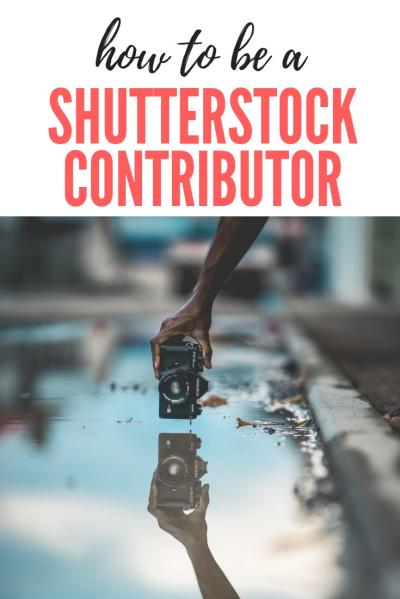Thinking about turning your photography or digital art into a source of income? Shutterstock is one of the biggest platforms out there for creative content, connecting talented contributors with millions of buyers worldwide. Whether you’re a seasoned photographer or just starting out, the Shutterstock Contributor Program offers a fantastic opportunity to showcase your work and earn royalties. The process is straightforward, and once you’re onboarded, you gain access to a global marketplace that can help elevate your creative career. In this guide, we’ll walk you through what
Prerequisites and Requirements for Becoming a Shutterstock Contributor

Before diving into the application process, it’s important to understand what Shutterstock looks for in its contributors. They want high-quality, original content that meets their standards, along with a few technical and legal requirements. Here’s a quick rundown:
- Age: You must be at least 18 years old to apply.
- Ownership: All submitted content must be your original work. You can’t upload images or videos you don’t own or have permission to use.
- Content Quality: Files should be well-lit, in focus, and free of noise or artifacts. High-resolution images (typically at least 4 megapixels) and videos are preferred.
- Legal Requirements: You need to have model releases for recognizable people and property releases for private property or trademarks, if applicable.
- Technical Specifications: Files must meet Shutterstock’s technical standards, including proper naming, color profiles (sRGB), and format (JPEG for images, MP4 for videos).
In addition to these, Shutterstock recommends that your portfolio showcases a diverse range of subjects and styles to increase your chances of acceptance. Remember, they review your submissions carefully to ensure quality and compliance, so take your time to prepare your best work before applying. Meeting these prerequisites sets the foundation for a smooth application process and a successful contributor journey.
Step-by-Step Guide to Applying as a Shutterstock Contributor
Getting started as a Shutterstock contributor might seem a bit daunting at first, but don’t worry—it’s pretty straightforward once you know the steps. Here’s a simple walkthrough to help you navigate the application process smoothly:
Step 1: Visit the Shutterstock Contributor Website
Head over to submit.shutterstock.com. This is the dedicated portal for new contributors. Take a moment to explore the site—it’s user-friendly and designed to guide you through the process.
Step 2: Create an Account
If you don’t already have an account, click on the “Sign Up” button. You’ll need to provide your email address, create a password, and agree to the contributor terms. Make sure to use an email you check regularly—Shutterstock may send important updates or requests for additional info.
Step 3: Fill Out Your Contributor Profile
Once registered, you’ll be prompted to complete your profile. Here, you’ll share some basic info about yourself, such as your name, location, and a brief bio. This helps Shutterstock understand your background and style, and adds a personal touch to your portfolio.
Step 4: Submit Your First Content
Before being approved, you’ll need to upload some sample images or videos. Shutterstock typically reviews your initial submissions to evaluate your style, quality, and adherence to their guidelines. Upload high-quality, original content that showcases your skills.
Step 5: Wait for Review and Approval
After submitting, your content will enter the review queue. This process can take anywhere from a few days to a couple of weeks. If your submissions meet Shutterstock’s standards, you’ll receive an email confirming your acceptance as a contributor. If not, don’t get discouraged—review feedback and try again!
Step 6: Start Uploading Regularly
Once approved, you can begin uploading your content directly through the contributor dashboard. Keep in mind, consistency and quality are key to building your portfolio and earning potential on Shutterstock.
Tips for Creating and Uploading High-Quality Content
To stand out and succeed as a Shutterstock contributor, focus on creating content that’s both high-quality and marketable. Here are some helpful tips:
- Focus on Technical Quality: Always upload images and videos that are sharp, well-lit, and properly exposed. Use professional equipment if possible, and pay attention to details like focus and color accuracy.
- Follow Shutterstock Guidelines: Review their content guidelines carefully. Avoid copyrighted material, and ensure your work is original. Remember, they prefer content that’s relevant and in demand.
- Research Market Trends: Browse Shutterstock’s popular categories to get a sense of what buyers are searching for—think lifestyle, travel, business, or technology. Creating content aligned with current trends can boost your sales.
- Use Clear, Descriptive Titles and Tags: When uploading, include accurate titles, detailed descriptions, and relevant keywords. This makes it easier for buyers to find your content.
- Pay Attention to Composition: Good composition can make a big difference. Use the rule of thirds, leading lines, and balanced framing to create visually appealing images.
- Maintain Consistency: Regular uploads help build your portfolio and improve your visibility on the platform. Set a manageable goal—whether it’s weekly or monthly—and stick to it.
- Optimize for Different Formats: Submit a variety of content types—photos, vectors, illustrations, videos—to diversify your portfolio and attract a broader audience.
Finally, always review your content before uploading. Double-check for any imperfections, watermarks, or copyright issues. High-quality content not only increases your chances of acceptance but also ensures you earn more over time. Happy creating!
Understanding Shutterstock’s Review Process and Approval Timeline
Once you’ve uploaded your images to Shutterstock, the next step is understanding how the review process works and what kind of timeline you can expect. Shutterstock has a pretty thorough review system in place to ensure that all content meets their quality and technical standards, which is great for maintaining a high-quality library for everyone.
Typically, after you submit your images, they go into a review queue. The review team, which is made up of experienced reviewers, checks each image for:
- Technical quality: Are the images sharp, well-exposed, and free of noise or artifacts?
- Content originality: Is the image unique and eye-catching?
- Compliance: Does the image adhere to Shutterstock’s content guidelines? This includes no watermarks, proper releases if people or property are recognizable, and no prohibited content.
On average, the review process takes about 1 to 3 business days. However, during busy periods or if your images need additional scrutiny, it might take a bit longer. If your images are rejected, Shutterstock provides feedback on why, so you can learn and improve for next time. Don’t be discouraged—many successful contributors had their early uploads rejected before fine-tuning their portfolio.
Once your images pass review, they go live on the platform and become available for licensing. You’ll receive an email notification, and you can also check the status of your submissions in your contributor dashboard. Keep in mind that the review process is ongoing, so regularly uploading fresh content can help you build momentum and increase your earnings.
Maximizing Your Earnings as a Shutterstock Contributor
Now that your images are approved and live, the next big question is: How can you maximize your earnings? Making the most out of your Shutterstock contributions involves a mix of strategic uploading, understanding licensing, and engaging with the platform smartly.
Here are some tips to help boost your income:
- Create High-Demand Content: Research trending topics, seasonal themes, and popular categories. For example, business, technology, health, and lifestyle images tend to perform well. Use keyword research tools or browse Shutterstock’s trending section to get ideas.
- Focus on Quality Over Quantity: Upload sharp, well-composed images that tell a story or evoke emotion. High-quality images are more likely to be downloaded and featured in premium collections.
- Optimize Your Keywords: Use relevant, specific keywords that accurately describe your images. Think about what buyers might search for and include synonyms. Well-optimized keywords increase your images’ visibility in search results.
- Diversify Your Portfolio: Upload various types of content—photos, vectors, illustrations—to appeal to different buyers and licensing needs. The more diverse your portfolio, the higher your chances of earning.
- Leverage Collections and Curated Galleries: Submit your best work to curated collections on Shutterstock. These collections often get more visibility and can lead to higher sales.
- Participate in Promotional Campaigns: Occasionally, Shutterstock runs promotional events or features certain categories. Contributing popular content during these times can boost your earnings.
- Stay Consistent: Regular uploads help keep your portfolio fresh and improve your search rankings. Consistency is key to building a steady income stream.
Finally, remember that earnings on Shutterstock grow over time. As your portfolio expands and you learn what works best, you’ll see your income increase. Keep analyzing your sales data, refine your keyword strategies, and stay active on the platform. With patience and persistence, you can turn your creative passion into a reliable source of income.
Common Challenges and How to Overcome Them
Getting started as a Shutterstock contributor can be an exciting journey, but it’s not without its hurdles. Many newcomers face similar challenges along the way, so knowing how to tackle them can make the process smoother and more enjoyable.
Challenge 1: Standing Out in a Crowded Marketplace
With millions of images on Shutterstock, it’s easy to feel overwhelmed. How do you make your work stand out? The key is to focus on quality and niche topics. Instead of trying to cover everything, specialize in a particular style, subject, or theme that you’re passionate about. This helps build your reputation as an expert in that area.
Solution: Research trending keywords and popular categories on Shutterstock. Create high-quality, original images that fill a gap or add a fresh perspective. Consistently uploading well-crafted content helps you gain visibility and attract repeat buyers.
Challenge 2: Navigating the Submission Process
Uploading images and ensuring they meet Shutterstock’s standards can sometimes feel tricky. From proper keywording to correct file formats, there’s a lot to keep track of.
Solution: Take the time to review Shutterstock’s contributor guidelines carefully. Use their recommended file formats and resolution standards. When it comes to keywords, be specific and relevant — think about what a buyer might search for. Keep a checklist to ensure each submission meets all criteria before uploading.
Challenge 3: Dealing with Rejections
Rejections are part of the process, but they can be discouraging. Understanding why your images get rejected is crucial to improving your submissions.
Solution: Pay close attention to the rejection feedback. Common reasons include poor technical quality, model releases missing, or inappropriate content. Use this feedback to refine your future uploads. Practice makes perfect, so keep experimenting and learning from each experience.
Challenge 4: Staying Consistent and Motivated
Building a portfolio takes time, and maintaining motivation can be tough, especially if sales are slow initially.
Solution: Set small, achievable goals, like uploading a certain number of images each week. Celebrate your progress and keep a positive mindset. Remember, consistency is key — the more quality content you upload, the better your chances of success.
By acknowledging these challenges and proactively addressing them, you’ll be better equipped to grow as a Shutterstock contributor. Stay patient, keep learning, and enjoy the creative journey!
Conclusion and Additional Resources for Aspiring Shutterstock Contributors
Embarking on your journey as a Shutterstock contributor can be both thrilling and rewarding. Remember, success doesn’t happen overnight. It takes dedication, a willingness to learn, and a bit of perseverance. By understanding the platform, honing your skills, and overcoming common hurdles, you’ll set yourself up for a fulfilling creative and entrepreneurial experience.
To help you along the way, here are some valuable resources:
- Shutterstock Contributor Academy: An official platform with tutorials, tips, and guidelines to improve your submissions.
- Community Forums: Connect with other contributors, share experiences, and get advice.
- Photography and Design Blogs: Stay updated on trends, techniques, and best practices.
- Keyword Research Tools: Use tools like Google Keyword Planner or Shutterstock’s own keyword suggestions to optimize your image metadata.
Most importantly, keep creating and sharing your unique perspective. Every image you upload is a step toward building your portfolio and establishing your presence in the stock photography world. Stay patient, stay passionate, and enjoy the process!


